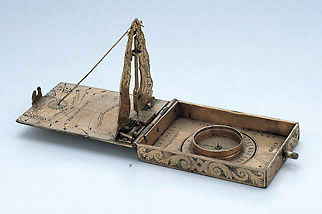
 |
| Catalogue |
 |
 Inclining Dial The outer face of the lid carries a table titled 'TAB: LATITVDINIS REGIONVM' giving the latitudes of 32 places in roughly alphabetical order. The inside face of the lid carries an inclining string-gnomon dial. There is a folding gnomon support which is held perpendicular to the dial plate by a sprung catch and whose two parts are decorated as fish. The integral plummet is positioned above a latitude scale from 44 to 52?, with dots every second degree, and the whole cover plate is pivoted on its hinges to set the dial for latitude. Around the edge of the dial plate runs the scale of hours from 4 to 12 to 8, divided to the half hours. The string emerges from an engraved representation of the sun and has a knot whose shadow indicates the declination of the sun against the zodiac lines on the central portion of the plate. The princaipl lines are labelled 'TROPCVS [sic] CANCRI', 'EQVINOCTIALIS' and 'TROPICVS CAPRICORNI'. On one side are the zodiac symbols for Cancer to Sagittarius marked 'SIGNA DECRESCE:' and on the other Capricorn to Gemini marked 'SIGNA CRESCE DIE'. Under the base of the gnomon support, and visible only when the support is folded, is the signature 'HOC OPVS FECIT ALEXIVS SCHNIEP DE MONACO'. The main box is hollow and the edges of its base are labelled with the names of the four cardinal directions in Latin. At the northern end is the date 'ANNO .1.5.7.8.'. In the centre is the compass, whose bowl is 23 mm in diameter and marked for variation. The compass can be rotated to set the variation; it sits on a circular disc half of whose circumference carries a scale of degrees 0 to 90 , 0 to 90, divided to 10 and 2 and numbered by 10. The degree scale is titled 'GRADVS DECLINATIONIS MAGNETIS A MERIDIANA LINEA'. The base of the instrument carries an engraved image of a female figure in an archway. She presumably represents the goddess Urania since she is looking up at the stars and holds an armillary sphere in one hand and a pair of dividers in the other, with a quadrant at her feet. Provenance: Lewis Evans Collection G. 394. Stephen Johnston |



